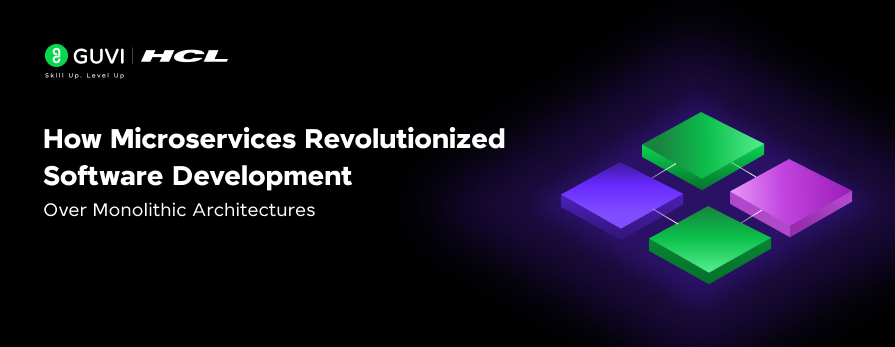
How Microservices Revolutionized Software Development Over Monolithic Architectures?
Mar 03, 2025 2 Min Read 1492 Views
(Last Updated)
The evolution of software architecture from monolithic to microservices has been one of the most significant shifts in the tech industry over the past decade.
This transition reflects the growing need for scalability, flexibility, and faster development cycles in modern applications.
Let’s dive into how microservices emerged from the traditional monolithic architecture and why they’ve become the preferred approach for many organizations.
Table of contents
- Understanding Monolithic Architecture
- Key Characteristics of Monolithic Architecture:
- Advantages of Monolithic Architecture:
- Challenges of Monolithic Architecture:
- The Rise of Microservices
- Key Characteristics of Microservices Architecture:
- Advantages of Microservices:
- Challenges of Microservices:
- Evolutionary Drivers
- Real-World Adoption
- Conclusion
Understanding Monolithic Architecture
Monolithic architecture refers to a traditional way of building software applications where all components are interconnected and interdependent. In a monolithic system, the user interface (UI), business logic, and data access layers are bundled together into a single, self-contained unit.
Key Characteristics of Monolithic Architecture:
- Tightly Coupled: All parts of the application are tightly integrated, meaning changes in one part can significantly impact others.
- Single Codebase: There is typically one codebase for the entire application, making it easier to develop at the outset but harder to manage as the application grows.
- Resource Intensive: Scaling a monolithic application often means duplicating the entire system, which can be resource-intensive.
- Slower Development Cycles: Because everything is interconnected, deploying new features or updates can be slow and risky, as it may affect the entire application.
Advantages of Monolithic Architecture:
- Simplicity: Easier to develop, test, and deploy in the early stages of an application.
- Performance: Communication within a monolithic application is faster because it doesn’t rely on network calls between different services.
Challenges of Monolithic Architecture:
- Scalability Issues: Difficult to scale specific parts of the application independently.
- Maintenance Complexity: As the application grows, the codebase becomes large and difficult to manage.
- Limited Flexibility: Technology stack and development language are often chosen at the outset and hard to change later.
The Rise of Microservices
As applications became more complex, the limitations of monolithic architecture became apparent. This led to the development of microservices architecture, which breaks down an application into smaller, loosely coupled services that can be developed, deployed, and scaled independently.
Key Characteristics of Microservices Architecture:
- Decoupled Services: Each service is a small, self-contained unit that focuses on a specific business function.
- Independent Deployment: Services can be developed, tested, and deployed independently, allowing for faster release cycles.
- Technology Diversity: Teams can choose the most appropriate technology stack for each service.
- Scalability: Individual services can be scaled independently, optimizing resource use.
Advantages of Microservices:
- Improved Scalability: Since services are decoupled, only the necessary components can be scaled.
- Faster Time-to-Market: Independent services allow for quicker iterations and more frequent releases.
- Resilience: If one service fails, it doesn’t necessarily bring down the entire system.
- Flexibility: Teams can use different programming languages, databases, and tools for different services.
Challenges of Microservices:
- Increased Complexity: Managing a large number of services requires a sophisticated orchestration strategy.
- Network Latency: Communication between services occurs over a network, which can introduce latency.
- Data Management: Distributed data management can be challenging, requiring strategies like eventual consistency.
- Operational Overhead: Monitoring, logging, and managing services at scale requires robust DevOps practices.
Evolutionary Drivers
Several factors drove the evolution from monolithic application development to microservices architecture application development:
- Demand for Scalability: As businesses grew, the need to scale specific parts of applications independently became critical.
- Agility in Development: The pressure to deliver new features faster and more frequently made microservices more attractive.
- Cloud-Native Environments: The rise of cloud computing, with its inherent scalability and flexibility, naturally aligned with microservices.
- Technological Advances: The emergence of containerization (e.g., Docker) and orchestration tools (e.g., Kubernetes) provided the necessary infrastructure to support microservices effectively.
Real-World Adoption
Many organizations, including tech giants like Netflix, Amazon, and Google, have adopted microservices architecture to overcome the limitations of monolithic systems. Netflix, for instance, transitioned from a monolithic architecture to microservices to handle its massive user base and the need for high availability and scalability.
There are various differences between microservices and monolithic architecture and it is important that you know them as a developer as that will help you decide when to use what!
In case if you want to learn more about microservices and monolithic architecture and gain in-depth knowledge on full-stack development, consider enrolling for GUVI’s certified Full-stack Development Course that teaches you everything from scratch and make sure you master it!
Conclusion
In conclusion, the evolution from monolithic to microservices architecture represents a fundamental shift in how software is developed, deployed, and managed.
While monolithic architectures may still be suitable for smaller, simpler applications, microservices offer a more scalable, flexible, and resilient solution for complex, modern applications. However, this evolution comes with its own set of challenges, making it crucial for organizations to weigh the pros and cons before making the transition.
As businesses continue to demand more from their applications, microservices architecture is likely to remain a key strategy in the software development landscape, driving innovation and efficiency in the digital age.
























![What Does a Front End Developer Do? A Beginner’s Guide [2025] 3 Feature image - What does a Front End Developer do A Complete Guide](https://www.guvi.in/blog/wp-content/uploads/2024/02/Feature-image-What-does-a-Front-End-Developer-do-A-Complete-Guide.webp)

![Top React Interview Questions and Answers! [Updated] 5 React Interview Questions](https://www.guvi.in/blog/wp-content/uploads/2022/01/Top-React-Interview-Questions-and-Answers.webp)





Did you enjoy this article?